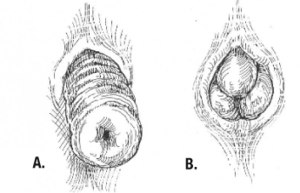Mucosal prolapse
| Rectal prolapse | |
|---|---|
 |
|
| A. full thickness external rectal prolapse, and B. mucosal prolapse. Note circumferential arrangement of folds in full thickness prolapse compared to radial folds in mucosal prolapse. | |
| Classification and external resources | |
| Specialty | General surgery |
| ICD-10 | K62.3 |
| ICD-9-CM | 569.1 |
| OMIM | 176780 |
| DiseasesDB | 11189 |
| MedlinePlus | 001132 |
| eMedicine | med/3533 |
| Patient UK | Rectal prolapse |
| MeSH | D012005 |
Rectal prolapse often used to mean complete rectal prolapse (external rectal prolapse), where the rectal walls have prolapsed to a degree where they protrude out the anus and are visible outside the body. However, most researchers agree that there are 3 to 5 different types of rectal prolapse, depending on if the prolapsed section is visible externally, and if the full or only partial thickness of the rectal wall is involved.
Rectal prolapse may occur without any symptoms, but depending upon the nature of the prolapse there may be mucous discharge (mucus coming from the anus), rectal bleeding, degrees of fecal incontinence and obstructed defecation symptoms.
Rectal prolapse is generally more common in elderly women, although it may occur at any age and in both sexes. It is very rarely life-threatening, but the symptoms can be debilitating if left untreated. Most external prolapse cases can be treated successfully, often with a surgical procedure. Internal prolapses are traditionally harder to treat and surgery may not be suitable for many patients.
The different kinds of rectal prolapse can be difficult to grasp, as different definitions are used and some recognize some subtypes and others do not. Essentially, rectal prolapses may be
External (complete) rectal prolapse (rectal procidentia, full thickness rectal prolapse, external rectal prolapse) is a full thickness, circumferential, true intussusception of the rectal wall which protrudes from the anus and is visible externally.
Internal rectal intussusception (occult rectal prolapse, internal procidentia) can be defined as a funnel shaped infolding of the upper rectal (or lower sigmoid) wall that can occur during defecation. This infolding is perhaps best visualised as folding a sock inside out, creating "a tube within a tube". Another definition is "where the rectum collapses but does not exit the anus". Many sources differentiate between internal rectal intussusception and mucosal prolapse, implying that the former is a full thickness prolapse of rectal wall. However, a publication by the American Society of Colon and Rectal Surgeons stated that internal rectal intussusception involved the mucosal and submucosal layers separating from the underlying muscularis mucosa layer attachments, resulting in the separated portion of rectal lining “sliding” down. This may signify that authors use the terms internal rectal prolapse and internal mucosal prolapse to describe the same phenomena.
...
Wikipedia
